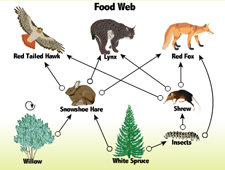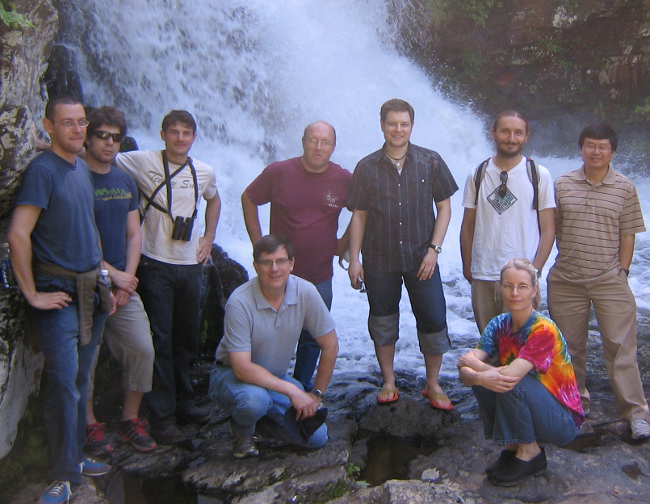| Description | Participants | Summaries | Products |
|---|

Archived NIMBioS Working Group
Food Web Dynamics
Topic: Food web dynamics and stoichiometric constraints in meta-ecosystems
Meeting dates: Apr 27-30, 2010; Jan 11-15, 2011; Dec 11-14, 2012
Organizers:
Mathew Leibold (Section of Integrative Biology, Univ. of Texas, Austin)
Robert Sterner (Ecology, Evolution and Behavior, Univ. of Minnesota)
Francois Massol (CEMAGREF, Aix en Provence, France)
Christopher Klausmeier (Kellogg Biological Station, Michigan State Univ.)
Objectives: Ecological stoichiometry and meta-community/-ecosystem theory are two recent approaches that have had success in explaining large-scale ecological dynamics and patterns. However they have developed independently and have addressed different aspects of ecology. This working group will synthesize these two approaches to food web/ecosystem dynamics and address important questions at the community/ecosystem interface. Interactions between stoichiometry and metacommunity processes are likely because the movement of organisms among patches involves the transfer of materials as well as changing the identity of species and their ecological traits. Although some consequences of this process have been identified in models with only a single limiting nutrient we know of no theory that links these two fundamental aspects of dispersal involving more than one nutrient (and thus addressing stoichiometric dynamics). We propose to bring together a group of theoretical and empirical ecologists and mathematicians to synthesize these two areas of ecological theory. Specifically, we will 1) construct a theoretical framework for modeling the interaction of multiple nutrients and multiple species in spatially heterogeneous landscapes; 2) develop mathematical tools to simplify these unwieldy models and efficient numerical tools to simulate them; and 3) analyze archetypical models to illustrate the novel phenomena that emerge when ecological stoichiometry is considered in a spatial setting. These activities will improve our understanding of basic issues in ecology. Given human impacts on both nutrient cycles (Vitousek et al. 1997) and the connectivity of ecosystems (Mack et al. 2000), these activities will also yield significant insights into applied problems as well.

Meeting Summaries
| Mtg # | Dates | Agenda | Summary | Photo | Evaluation |
|---|---|---|---|---|---|
| 1 | Apr 27-30, 2010 | Link | Link | Report | |
| 2 | Jan 11-15, 2011 | Link | Link | Report | |
| 3 | Dec 11-14, 2012 | Link |
Meeting 1 Summary. During the first meeting, the Food Web Dynamics Working Group focused on several modeling issues: 1) modeling Odum’s ideas of dynamic succession to gain quantitative insights into their implications; 2) modeling the idea of the Redfield ratio (the match between input stoichiometry and biotic stoichiometry) to consider the implications for spatially distributed landscapes; 3) modeling community assembly to understand how community composition tracks (or doesn't) local environmental stoichiometry; and 4) relating complex food webs to spatial stoichiometry.
Meeting 2 Summary. Meeting 2 summary. The group summarized progress on projects made since the previous meeting. The group continued work on those projects as subgroups, as described in summary report from the first meeting. A review of "ecosystem homeostasis" with emphasis on stoichiometry that would also solidify empirical links was initiated. The group's objective is to use stoichiometry as a way to focus on ecosystem homeostasis and to evaluate how important spatial dynamics are in strengthening such homeostasis.
Between meetings one and two, the following review of spatial food webs was published in Ecology Letters: Massol F, Gravel D, Mouquest N, Cadotte MW, Fukami T, Leibold MA. 2011. Linking community and ecosystem dynamics through spatial ecology. Ecology Letters, 14(3):313-323.
Three projects are now fairly well developed and should be soon ready for manuscript preparation, with final manuscript preparation done by the third meeting. The manuscripts include as follows: (1) the minimal model for spatial stoichiometry; (2) processing chain models in spatial settings; and (3) resource ratio theory in diffusive models. Other projects that are progressing include "Odum in equations" and a review of stoichiometry as a focus of ecosystem homeostasis.
 |
| Meeting 1 participants. Standing, from left: Christopher Klausmeier, Dominique Gravel, Tanguy Daufresne, Mathew Leibold, Irakli Loladze, Francois Massol, Yang Kuang. Seated: Robert Sterner, Laura Jones |
NIMBioS Working Groups are chosen to focus on major scientific questions at the interface between biology and mathematics. NIMBioS is particularly interested in questions that integrate diverse fields, require synthesis at multiple scales, and/or make use of or require development of new mathematical/computational approaches. NIMBioS Working Groups are relatively small (up to 10 participants), focus on a well-defined topic, and have well-defined goals and metrics of success. Working Groups will meet up to 3 times over a two-year period, with each meeting lasting up to 2.5 days.
A goal of NIMBioS is to enhance the cadre of researchers capable of interdisciplinary efforts across mathematics and biology. As part of this goal, NIMBioS is committed to promoting diversity in all its activities. Diversity is considered in all its aspects, social and scientific, including gender, ethnicity, scientific field, career stage, geography and type of home institution. Questions regarding diversity issues should be directed to diversity@nimbios.org. You can read more about our Diversity Plan on our NIMBioS Policies web page. The NIMBioS building is fully handicapped accessible.
NIMBioS
1122 Volunteer Blvd., Suite 106
University of Tennessee
Knoxville,
TN 37996-3410
PH: (865) 974-9334
FAX: (865) 974-9461
Contact NIMBioS


